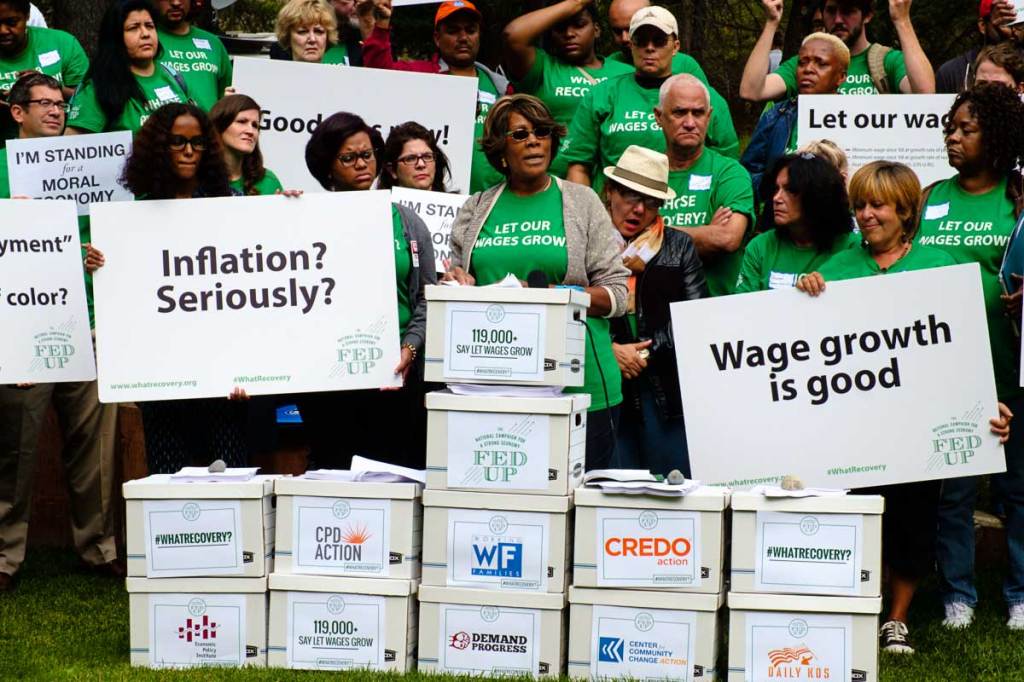 Jean Ross/Ford Foundation
Jean Ross/Ford FoundationJust a few short months ago, conventional wisdom held that the Board of Governors of the Federal Reserve would begin raising interest rates at its September meeting. While turmoil in global financial markets no doubt played a role in the recent Fed decision to leave interest rates unchanged for the time being, the foundation-supported Center for Popular Democracy’s Fed Up campaign did a masterful job of reaching Fed members, and the public at large, with an emphatic message: Interest rates must remain low, keeping inflation in check so that wages can rise and everyone—in all communities—can find a good job.
The Fed Up campaign, just a year old, had developed a strategy that culminated in late August when, just three weeks before the Fed’s critical meeting, the central bank held its annual policy symposium in Jackson Hole, Wyoming. Fed Up had scheduled an event in Jackson Hole, as well—an alternative policy conference entitled Whose Recovery? A National Convening on Inequality, Race, and the Federal Reserve. The counter-conference drew more than 100 low-wage workers, organizers, and economists from each of the Fed’s 12 regions and featured two days of teach-ins about the outsize influence the Federal Reserve’s decisions have on our economy, the urgent need for public accountability, and the importance of prioritizing wage growth and full employment. Conference highlights included impromptu remarks by Council of Economic Advisers Chair Jason Furman, also a featured speaker at the Fed symposium; University of California, Berkeley, economist Brad DeLong; as well as organizers and economists from the foundation-supported Economic Policy Institute, Roosevelt Institute, and Center for Economic Policy Research, in sessions ranging from “Do Black Lives Matter to the Fed” to “The Most Important 2016 Elections You’ve Never Heard About,” on the process for selecting the leadership of the Federal Reserve system.
Benefitting from the press presence already in Jackson Hole for the Fed symposium, the event was covered by more than 30 national news outlets, including the Wall Street Journal, the Washington Post, Politico, and the New York Times, where “Challenged on Left and Right, the Fed Faces a Decision on Rates” was the lead Labor Day story. A Huffington Post reporter summed up the success of the campaign as follows:
Fed Up has managed to turn the esoteric issue of central bank interest rates into a key element of the progressive agenda—and a rallying cry for low-income workers . . . the size of Fed Up’s delegation of activists and presence of prominent economists—including Nobel laureate Joseph Stiglitz—attests to the rapid growth of a once-unlikely campaign that began just a year ago.
The campaign had already begun making inroads earlier this year, when the Fed, in response to Fed Up’s demand for a structure that allows the voices of working families to be heard, established an advisory council of consumer advocates and community representatives that will meet twice yearly with the bank’s leadership and weigh in on a range of issues. Building on this successful first year, campaign organizers plan to continue their efforts to educate the public, as well as Fed leaders, on the tremendous racial and economic disparities that still afflict the economy—and they see the 2016 elections as an opportunity to steer the conversation to the need for genuine full employment that creates rising wages and more jobs for all communities.
